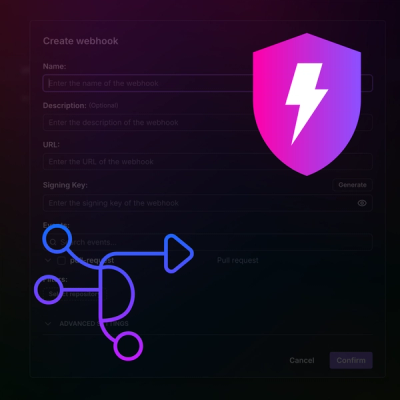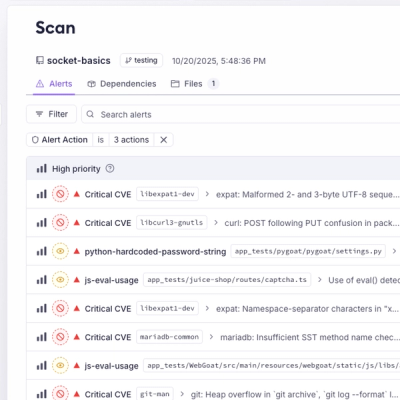
Product
Introducing Webhook Events for Pull Request Scans
Add real-time Socket webhook events to your workflows to automatically receive pull request scan results and security alerts in real time.
behavior-graph
Advanced tools
Behavior Graph lets you build your programs out of small, easily understood pieces in a way that lets the computer do more of the work for you.
Behavior Graph lets you build your programs out of small, easily understood pieces in a way that lets the computer do more of the work for you.
It is an architecture and supporting library that simplifies the type of complexity that comes with event-driven software, such as user facing applications and control systems.
It's also a fun way to program.
It is particularly helpful for developers building:
We originally developed it for ourselves to use in a video playing library at Yahoo. Even though we had experienced engineers and excellent test coverage, we still struggled with the complexity of the codebase. Behavior Graph is our solution.
It's also possible you're the type of person who likes nerdy new software ideas. (Seriously though, who doesn't, amirite?) If that's the case, we guarantee you will find Behavior Graph interesting.
Behavior Graph introduces a handful of new concepts. These concepts aren't difficult, but you will require some orientation.
As programmers it's natural to partition our software into subtasks. For example, let's consider what happens on a typical login form.
Most programming languages offer functions as the primary tool for creating these subtasks. Conceptually we have three subtasks. So we will create three corresponding functions: validateFields, networkLogin, and updateUI. We will also need an additional onLoginClick function to run these tasks. It will look like this:
function onLoginClick() {
validateFields();
networkLogin();
updateUI();
}
Our four functions are not independent, however. There are dependency relationships between them that need to be respected.
validateFields depends on onLoginClick being run.networkLogin depends on onLoginClick being run, and it depends on the results of validateFields.updateUI depends on the results of both validateFields and networkLogin.But looking at the code, there is nothing that says, networkLogin depends on validateFields. Instead, we implement this relationship by calling our functions in a specific order. If we were to call networkLogin() before validateFields(), the feature wouldn't work.
So as long as we are organizing our code using only functions, we will need to implement part of our logic in terms of ordered function calls. This is because function definitions cannot express dependency relationships directly. There is no other way.
We could do more by using parameters and return values (aka functional programming), but that still wouldn't remove the need to call these functions in a valid order. Calling something like networkLogin(validateFields()) is still a sequence of function calls.
It is the job of the developer to translate these dependency relationships into sequenced function calls. This requires time and effort:
We're proposing that maybe all this work isn't necessary. What if function definitions could express dependency relationships?
Behavior Graph is a library that provides this alternative. It introduces a new unit of code organization called the behavior. It is a block of code together with its dependency relationships.
Unlike functions, behaviors are never called directly. Instead, behaviors declare their interfaces using reactive containers of data called resources. When data in these resources changes, Behavior Graph knows that any dependent behaviors need to run. Behaviors together with resources form a graph. (A graph of behaviors! Get it?!)
This gives us:
Behavior Graph isn't a replacement for functions. (We wrote it with functions, hello!) Instead it gives us higher level abstractions for partitioning our code into subtasks. It lets us say "these two blocks of code are related and here's how". And with that information the computer is able to run things for us. And humans are better able to infer the intent of the code.
Behavior Graph is a small library. It's around 1500 lines of formatted code. It has no dependencies.
It is easy to introduce into a codebase incrementally. It is designed to work side by side with existing code. We went through this incremental migration process ourselves.
A complex codebase is exactly where it brings the most benefit. Our team uses it daily in a codebase where the status quo wasn't good enough.
Behavior Graph has been ported to multiple platforms.
This Javascript/Typescript version is not used in production at Yahoo currently. It is a direct port from the original Objective-C. It has excellent test coverage. We are confident it works as intended.
But it is also newly open sourced. You won't find blog posts and Stack Overflow answers to your questions. If you are on a team that expects that type of support you should proceed with caution.
If you are building a browser based app using imperative UI libraries such as JQuery or direct DOM manipulation we think you should be fine. But if you are using any of the popular reactive UI frameworks such as React, Angular, or Ember you will need to figure out how to make that work. We do not have existing adapters.
Would like to help us with any of these adapters? We would certainly love to have your help. Please reach out to us on discord.
Javascript Behavior Graph is hosted on NPM @ behavior-graph.
Behavior Graph is also available via a number of popular CDN Services. You may prefer to use these when importing directly into the browser or with Deno.
Go here for the full documentation site.
While there are only a handful of basic concepts in Behavior Graph, it does require a shift in thinking. We recommend you start with the Getting Started guide then work through the Tutorials.
We really do need help and we really do like talking about Behavior Graph. Discord is a good place for that.
Behavior Graph builds on concepts from reactive programming. It uses the same underlying idea to automate control flow by using existing dataflow dependencies.
However, programming with Behavior Graph feels different than when using other reactive programming libraries. It is not functional reactive programming. It is not built around streams. And it is not optimized for assembling observable chains of data transformations.
Behavior Graph is also not a reactive UI library. You should continue to use your preferred UI framework of choice.
Instead Behavior Graph gives developers a tool for organizing their software around dependency relationships. We consider the following features essential for this:
There's always trade-offs with any programming paradigm (even the one that ships with your preferred programming language). We have worked hard to keep Behavior Graph from forcing you into a corner. It is designed to be compatible with existing code.
Wherever you feel friction, just don't use it.
Here are some challenges based on our own experience using it daily:
If you search on the internet for "what is reactive programming" you are likely to end up more confused than before you searched. For us, the benefits are all about simplifying control flow. We can see this in spreadsheet formulas. They are an easy example of how reactive programming improves the user experience.
In spreadsheet software, a formula often depends on the contents of other cells. When the contents of those cells change, the formula that depends on them is rerun. The formula's cell then updates with the new results. This updated cell then causes any formulas that depend on it to rerun. This process cascades across the cells in the spreadsheet. Formulas run at the correct time because the computer has automated the control flow for us. It knows how to do this because the formulas already specify what other cells they depend on.
Now, let's imagine a different type of spreadsheet program. In this one, the program does not automatically run formulas for us. Instead it requires us to do this manually. After we type in a formula for what a cell should display, we also need to type in which formulas should run whenever it updates. For example, if cells B1 and C1 depend on A1, then the formula for A1 needs to explicitly tell them to run. This might look like this:
A1 := 1 / 1000
runFormulaFor(B1)
runFormulaFor(C1)
That's it. That's the feature. Would you switch to this new spreadsheet program?
No, because it's bad idea.
Even if we get the control flow correct, every change we make comes with potential control flow errors. We need to mentally walk backwards and forwards along some implicit dependency graph to ensure that formulas are still running in the correct order. For example, what would happen if someone else comes along and changes the formula for B1 so that it also depends on C1? The formula for A1 becomes wrong because it's calls are in the wrong order. We need to run the formula for C1 first. Maintaining a large spreadsheet like this would be madness.
But this is exactly what we do as programmers on a daily basis.
FAQs
Behavior Graph lets you build your programs out of small, easily understood pieces in a way that lets the computer do more of the work for you.
We found that behavior-graph demonstrated a not healthy version release cadence and project activity because the last version was released a year ago. It has 1 open source maintainer collaborating on the project.
Did you know?

Socket for GitHub automatically highlights issues in each pull request and monitors the health of all your open source dependencies. Discover the contents of your packages and block harmful activity before you install or update your dependencies.

Product
Add real-time Socket webhook events to your workflows to automatically receive pull request scan results and security alerts in real time.

Research
The Socket Threat Research Team uncovered malicious NuGet packages typosquatting the popular Nethereum project to steal wallet keys.

Product
A single platform for static analysis, secrets detection, container scanning, and CVE checks—built on trusted open source tools, ready to run out of the box.